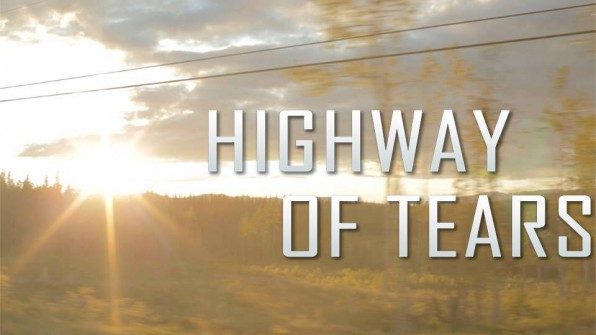“Go ahead. Tell Someone. No one will believe you. Once a whore, always a whore.” – Former Judge David William Ramsey
March 1st, 2014. Mercer Consulting issued their annual Quality of Living Survey which ranks the top cities in the world. The 2014 survey has Vancouver ranked fifth globally after Vienna, Zurich, Auckland and Munich. As impressive as that is, Vancouver took top honours as the most livable city in North America. Four hundred and sixty-five miles due north lies Prince George, the fourth largest city in the province of British Columbia and the gateway to the north. For a province so rich in natural resources, breathtaking vistas and clearly anointed with the trappings of a first world pedigree, all is not well in lotus land. Highway 16, the 724 kilometre stretch between Prince George and Prince Rupert has become a killing field for mostly young First Nations women over the last 40 years.
Dubbed the Highway of Tears, this unforgiving commuter corridor became a serial killer’s playground as vulnerable young women with limited access to social services gambled their lives each time they hitch-hiked. But, this story cuts much much deeper than that. Indian residential schools, negative stereotypes, systemic and socio-economic suppression, mistreatment by authorities, generational poverty and domestic violence have all played a part in allowing this forty year atrocity to fester. With the Highway of Tears serving as the nucleus of a much larger systemic problem, we are taken on a tragic ride-a-long that investigates the treatment and mistreatment of the First Nations population since colonization by delving into a contentious societal narrative that continually fails the most vulnerable seeking social justice and equality in Canada.
Director, Matt Smiley front loads Highway of Tears by offering irrefutable fact-based statistics that sets an uneasy tone for what’s to come. Reference to the 2013 Human Rights Watch Report stating the failure of The Royal Canadian Mounted Police (“RCMP”) in Northern B.C. to protect aboriginal women was the first salvo. With aboriginal women experiencing 3 to 5 times more violence than non-aboriginal women, it was no surprise that 582 First Nations women have been reported missing or murdered across Canada. Highway of Tears drives this point home with a slick heart-felt montage of women, à la America’s Most Wanted; of the missing and murdered victims whose remains dot that infamous corridor. These atrocities drew very little ink from mainstream media and even less attention within the RCMP ranks.
It took the death of Nicole Hoar, a 25 year old white girl last seen hitch-hiking on June 21st, 2002 to ignite media frenzy and galvanize efforts within the RCMP. The optic of the Nicole Hoar case further reinforced the systemic racism the indigenous communities across Canada have witnessed for decades within media and law enforcement. The 1958 hit, “Squaws Along the Yukon” further validated the objectification of natives to no end. But, in order to get to the roots of First Nations despair, one needs to turn back a century to the forced assimilation programs through government controlled institutions known so innocently as, Indian Residential Schools.
For nearly 150 years, mandatory attendance for aboriginal children ages 7 to 15 in residential schools served in removing them from their families in order to “kill the Indian in them” thus expediting their conversion into mainstream Canadian culture. With approximately 80 thousand children indoctrinated into this cultural whitewash, the tenants of this reprogramming insured First Nations children could, not speaking their native language, not having contact with parents, grand-parents and community and not be able to practice their indigenous culture. Smiley’s powerful use of a split screen archival still showing the before/after image of an indigenous boy is a disheartening representation of successful assimilation and the first disruptor of many that continues to resonate today.
Strategies of power are always intertwined with race and class. Still, it took nearly 10 years for the Canadian government to partner with aboriginal organizations to begin efforts of reconciliation and counseling to survivors of residential school programs leading to an official apology from Prime Minister Stephen Harper in 2008. But, this in no way alleviated the chasm of trust that still exists between the RCMP and the First Nations community. The egregious language surrounding the case of Former Judge David William Ramsey only fanned the flames of mistrust as he used his judicial position to subjugate his victims completely. The most devastating revelations are the after effects of the missing and murdered on their families and community as they confront a myriad of questions that will never get answered.
Verdict: 3.5 out of 5: This cinematic dissertation surrounding class and race in Canada is a compelling narrative that Matt Smiley has seamlessly woven throughout Highway of Tears. With poignant narration by Nathan Fillion of Castle fame setting the tone, this weighty subject matter may run long but never thin. Smiley makes no apologies for where the faults lie and isn’t opposed to turning the mirror inward on the aboriginal community if necessary. Questions surrounding generations of mistrust by the First Nations community towards the federal government are re-examined as entrenched views on both sides get aired. Personal stories of the missing and murdered gets a fresh retelling through tears. There are certain known and unknowns at the heart of this tragic story. The Who, Where, When and How surrounding most of these cold-cases were never in question. Highway of Tears attempts to make sense of the last unknown that still resonates never dimming with the passage of time . . . the Why?
Some tears will never dry.
Genre: Documentary
Language: English
Country: Canada
Director: Matt Smiley
Writer: Matt Smiley
Producers: Matt Smiley, Carly Pope
Executive Producer: Luis Felipe Fernandez-Salvador y Campodonico
Production Co.: Finesse Films
Runtime: 78 minutes
Screening Date: March 6th, 2014 – Bell TIFF Lightbox
Website: http://www.highwayoftears.ca/
T-Mak World: Toronto’s Site for Music, Movies and Culture www.tmakworld.com | Twitter | Facebook Get the T-Mak World Toolbar below to get all the info you need

